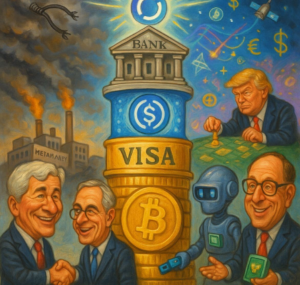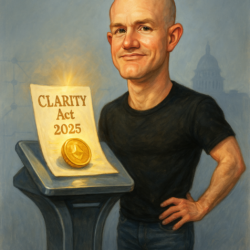 One of the most anticipated IPOs of 2025, just got…bigger.
One of the most anticipated IPOs of 2025, just got…bigger.
Circle (NYSE:CRCL), the USDC stablecoin issuer (who tried to IPO in 2021) just upsized its mega IPO. Instead of the $24 to $26 range. They priced it at $31 a share, pulling in $1.05 billion.
The reason is because of the wild institutional demand. And my take is this could be one of the most important IPOs of the year.
Which naturally begs the question, could this be one of the best buys of 2025?
But the bigger story isn’t just whether Circle will pop post-IPO. It’s what this means for the entire global financial system.
Two things are in play now:
- The redollarisation of global trade (except this time via stablecoins, not petrodollars or SWIFT).
- Crypto bleeding into TradFi in a way that is now permanent, structural… and highly profitable.
IPO wave meets bitcoin-backed corporate strategies
To start with, look at what’s happening around Circle’s mega-IPO.
The eToro (NASDAQ:ETOR) IPO is up 25% in a matter of weeks, fuelled by its pivot to tokenised and crypto assets. Investors are clearly hungry for public companies that can profit from this convergence of crypto and traditional finance.
There’s Cantor Equity Partners’ SPAC (NASDAQ:CEP), merging with 21Capital. I’ve written about this before, but they’ve now added around 25,000 bitcoin to their treasury. This is effectively a backdoor play on Tether’s market leadership. The SPAC itself (even without the merger) is up over 4x on the back of the proposed deal.
Meanwhile, the global corporate treasury trend I’ve been writing about is accelerating.
Japan’s Metaplanet (TYO:3350) (the so-called “Strategy of Japan”) continues to aggressively add bitcoin to its balance sheet. It now holds 8,888 bitcoin after their recent purchase.
The UK’s Smarter Web Company (LSE:SWC) (the so-called “Strategy of UK”) is doing what it can to add to its bitcoin bags too, raising £13.4 million this week, and now holding 122.76 bitcoin.
Now K Wave Media (NASDAQ:KWM) (a major player in Korean entertainment and digital content) has announced a $500 million bitcoin treasury move. Its stock jumped 133% in a single session this week from that announcement.
And Nano Labs (NYSE:NA), which had long been a quiet bitcoin holder, all of a sudden became known on social media, sending its stock up 71% in the day’s trading because they hold a decent chunk of bitcoin (and they make chips for bitcoin and crypto mining).
This is no longer a collection of isolated events. It is a coordinated market signal that corporate moves to bitcoin and now stablecoin infrastructure is being rewarded big time.
The rise of the SmartDollar Stack
However, the bigger story lies in what I call The SmartDollar Stack.
- The foundation: bitcoin as the strategic collateral layer.
More companies are holding BTC because they see what’s coming — inflation, currency devaluation, and an eventual “bitcoin standard” for treasury management. Not as a speculative side bet, but as core strategic collateral. - The application layer: USD stablecoins as the global settlement layer.
USDC, USDT and others are becoming the digital plumbing of global trade — faster, cheaper, programmable, borderless. For corporates and trade partners, stablecoins already offer a superior experience to legacy banking. - The settlement layer: US bitcoin-backed companies, banks, payment processors and digital trade organisations
21Capital, Strive Asset Management, Strategy, Metaplanet, Visa, PayPal, providing the services and trade functionality to make this system scalable globally and investable attracting huge sums of capital to feed back into the stack.
This is what I believe to be the new architecture of global finance.
A SmartDollar Stack, bitcoin-backed, USD-denominated, running on crypto-native infrastructure that largely circumvents central banks and traditional monetary control.
4D Chess on Trump’s part or an inevitable outcome?
The GENIUS Act and the STABLE Act are both advancing under the Trump administration and are now poised to provide legitimacy to this idea.
This is not some fringe experiment anymore. It is becoming US economic policy. And that alignment matters, because it gives both Wall Street and global markets confidence that this system is here to stay.
And behind the scenes? Some of the world’s largest US banking institutions are already quietly aligning with this trend.
You don’t see it in big headlines but custodians like BNY Mellon and State Street are building services to support institutional grade stablecoin and bitcoin holdings.
I remember speaking to a BNY Mellon executive a couple of years ago at a function and he was saying they were already heavily developing their crypto custody solutions for things like stablecoins.
JP Morgan’s Kinexys platform (formerly Onyx) already handles billions in tokenised assets, and I expect will be a massive gateway to future stablecoin flows.
The reality is US banks don’t want to fight the SmartDollar Stack. They want to profit from it. And by offering custody, settlement and rails infrastructure, to enable what’s coming they position themselves as essential players in this next wave.
Which only strengthens the stack further making it more “institutionally acceptable” and hence, globally acceptable.
So, the question now is this, is what we’re seeing simply a big coincidence, or is it a deliberate strategy?
When you map it all out, it becomes clear this is no accident.
We are seeing:
- US policy alignment through pending legislation
- Banking sector buy-in at the infrastructure level
- Corporate behaviour shifting toward bitcoin-backed treasury and stablecoin-driven trade
- Global market demand accelerating adoption
Some say this is 4D chess. Others 5D. Maybe it’s just economic inevitability.
But it’s not just about crypto, not just about bitcoin not just about stablecoins. It’s about a complete rebuilding of how global trade works.
As the US faces its own fiscal challenges (and likely further dollar devaluation) because they will no doubt turn on the money printer again, exporting bitcoin-backed, USD-denominated stablecoins could be the smartest play available.
By effectively leaving The Fed behind, they could strengthen US influence in global trade, while giving American corporates and investors new engines of growth. Sure, the mainstream will have you think that Trump is going to devalue the USD into oblivion, but do you really think that Larry Fink, Jamie Dimon (while he’s still there) and the other big hitters of global institutional force will just sit idly by?
Nope. They see this as a way to retain power and control.
In this light, Circle’s IPO isn’t just about Circle. It’s another vital brick in this emerging SmartDollar Stack. It is a public market vehicle that lets investors directly participate in the build-out of this new financial architecture.
And this wave of TradFi/DeFi fusion is now lifting stocks from Tokyo to London to New York, to new heights.
I believe the Circle IPO might just end up as a pivotal moment in the very function of the global economy.
And I’d say watch as the SmartDollar Stack builds and unfolds across the world.
I’ll be tracking its evolution and letting you know about it here in Investor’s Daily because more dots will connect and those who recognise the set-up early stand to profit the most.
Until next time,

Sam Volkering
Contributing Editor, Investor’s Daily


